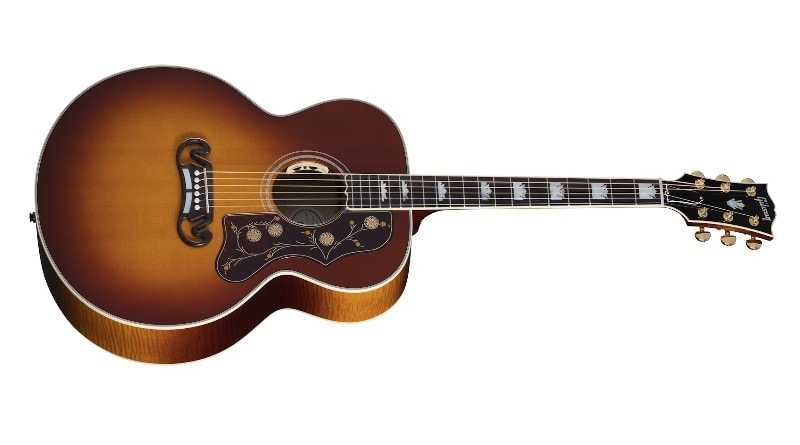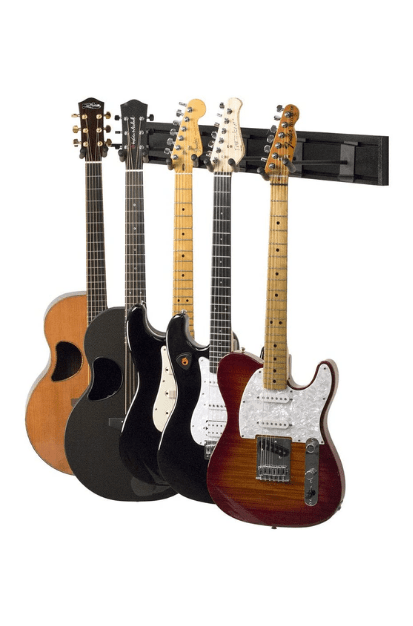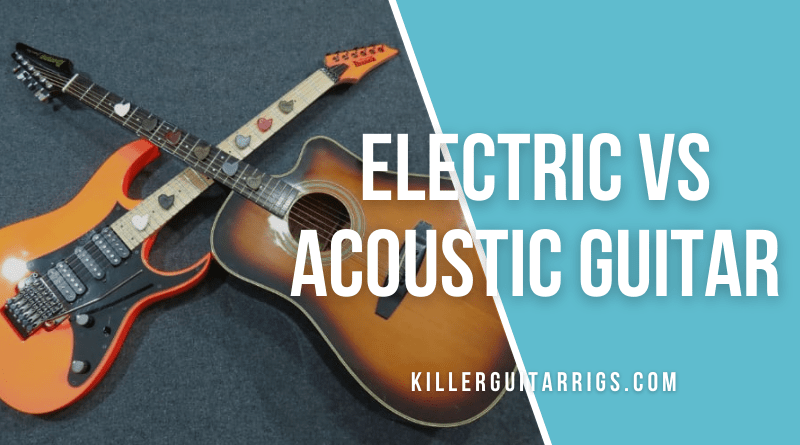The main difference between an electric and an acoustic guitar is that the former uses electrical pickups for sound to be heard through an amplifier or speaker, whereas sound is heard through the soundhole of an acoustic since the vibrations of the strings resonate within its body.
The trouble with being a beginner in this modern world is that one does not know where to begin when trying to learn a new skill. This applies to those who want to play guitar as well. The first big question is always which one to get, electric or acoustic?
So if you are looking for an answer to this question or simply want to know more about the two then read on to find out more:
Contents
Electric Guitar

An electric guitar uses pickups in its body to convert the vibrations of the strings into electrical energy. This is then transformed into sound when played through a speaker such as an amplifier.
Without external amplification, the sound produced by the guitar is minimal and therefore cannot be heard.
But what makes them so popular is that one can produce many different kinds of tones with them and there is no limit to how loud or soft their volume can be.
History Of The Electric Guitar
It is widely believed that the first electric guitar was built in 1932 as big band music started to gain popularity. As the music started to get louder, incorporating more orchestral instruments, there was a need for the guitar to be amplified.
One of the earliest guitar companies was Rickenbacker, founded by Adolph Rickenbacker, Paul Barth, and George Beauchamp of the National Guitar Corporation. They invented and subsequently commercially started to manufacture the first guitar pickup, which has since shaped modern music as we know it today.
By the late 1930s, guitar brands such as Gibson, Vega, Epiphone, Dobro, etc started to produce different models of electric guitars, including solid-body guitars.
Spearheaded by the likes of Les Paul, Sister Rosetta Tharpe, and T-Bone Walker, the electric guitar became a prominent part of music in the 1950s and 1960s.
The earliest known recording of an electric guitar is Georges Barnes’ ‘It’s A Low Down Dirty Shame’. Listen to it here:
Types Of Electric Guitars
While all electric guitars have the same anatomy and similar components used in making them, different models sound different. This is because of factors such as the type of wood or pickup used, the shape of the neck or body, and even the size of the guitar.
A standard electric guitar is 25.5 inches in scale length and around 38 inches in total length. They have six strings that are tuned to E, A, D, G, B, and E from strings 6 to 1.
When we say ‘electric guitar’ we generally refer to solid-body guitars which are made out of hardwood and have a hard polymer finish. The first solid-body guitar was invented by Gibson and by the 1970s, different manufacturers had solid-body models with 2 or 3 pickup configurations.
Today you will find electric guitars in all different shapes and sizes at a music store. While different models sound different, they all have 1 thing in common: they need pickups to convert the vibrations from the strings to electrical energy, which is then amplified for the sound to be heard.
Famous Guitars
We often associate some models of guitars with prominent guitar players who made it their signature sound. Here are some examples:
- Jimi Hendrix and his Stratocaster
A Stratocaster was always Jimi Hendrix’s choice of guitar and he paved the way for many rock and roll musicians with his innovative tone and playing.
- Jimmy Page and his Les Paul
While he has played many different types of guitars, it was his 1959 Les Paul that can be heard on Led Zeppelin albums such as ‘Led Zeppelin II’.
- Prince and his Cloud guitar
Known for his unique sound and also for using custom-made guitars throughout his career, Prince’s ‘The Cloud’ guitar was exclusively built for him by luthier Dave Rusan.
- Randy Rhoades and his ‘Concorde’
Randy Rhoades, who inspired the likes of Kirk Hammet, Marty Friedman, and Gojira’s Christian Andreu, played a signature Flying V, manufactured by Jackson guitars.
- George Harrison and the Rickenbacker 360/12.
George Harrison popularised Rickenbacker 13 string guitar when he played it during The Beatles’ live performances in the 1960s.
Advantages Of An Electric Guitar:
- Electric guitars can be more versatile if you add effects pedals to shape and color your tone. Although you can use a few pedals on acoustic guitars as well, not all pedals work on the acoustic. If you would like to know more about different kinds of effects, you can read our guide here.
- Since the string tension is low, it is easier to play an electric guitar than an acoustic. You require much less effort to hold down notes on a fretboard.
- You can control the volume of your electric guitar easily. This gives you the flexibility to play loud or soft, depending on what your music requires.
Disadvantages Of An Electric Guitar:
- You need an amp or a computer with a DAW to hear sound from your electric guitar. Since these do not produce sound on their own, you are dependent on an external source to hear yourself.
- They can often be expensive. While there are many beginner guitars for those on a budget, the cost of playing an electric guitar increases significantly when you add effect pedals, amps, and other accessories to the mix to play it.
Acoustic Guitar

An acoustic guitar has a hollow body. When you pluck the strings, they vibrate near the bridge. This resonates throughout the body of the guitar. The resonance reacts with the air in the guitar and thus sound can be heard through the soundhole.
One can either use their fingers or a pick (plectrum) to produce sound.
History Of The Acoustic Guitar
While historians have not been able to give us an exact date on the origin of the acoustic guitar, the modern acoustic guitar can be traced back to the late-medieval ‘guitarra latina’ in Spain. This instrument had four strings and a narrow, deep waist.
Similar to a lute or a ‘vihuela’, the strings of the guitar during the 16th century were tuned to C, F, A, D. By the 1800s, two more single strings were added to the instrument and the tuning was changed to the standard tuning that we use even today.
The design of the modern acoustic guitar is attributed to Antonio Torres Jurado who made improvements to its tone, volume, and sound projection in the 1850s. The guitar was slowly incorporated into classical and orchestral music. It thus transformed from an amateur to a professional instrument.
Since classical guitars did not have a loud enough projection, banjos remained the more popular choice until C.F. Martin developed the modern ‘dreadnought’ style of guitar which had a larger body, resulting in a louder volume. Thus the guitar started to be incorporated by jazz musicians at the time, before gaining popularity among other genres of music.
Over the years, many different types of acoustic guitars have been invented and they continue to be a part of popular music even today.
Types Of Acoustic Guitars
An acoustic guitar can be of many different kinds. Some of the most common ones based on their size are:
- Parlor
- Concert, Grand Concert
- Auditorium, Grand Auditorium
- Dreadnought
- Jumbo
- Mini
These guitars all have a standard tuning and use steel strings. Nylon-string acoustic guitars are popular in classical music, where the player often uses a fingerstyle technique to play.
Famous Acoustic Guitar Players
- Django Reinhardt
One of the most prolific jazz guitar players of all time, many compositions by Django Reinhardt are now considered jazz standards.
- Andy McKee
An exponent of the fingerstyle technique, Andy McKee treats the guitar as much as a percussive instrument as a melody one.
- Joni Mitchell
The Grammy-winning musician has influenced generations of folk and pop songwriters with her music.
- Charo
With a career spanning many decades, Charo remains a well-loved flamenco guitar player and singer.
- Elizabeth Cotten
While many enjoy the ‘cotten picking’ style of playing acoustic guitar, few know that it comes from Elizabeth Cotten’s unique and revolutionary style. Being a left-handed guitarist, she played the instrument upside down since it was originally intended for right-handed musicians.
Advantages Of An Acoustic Guitar
- The biggest advantage of owning an acoustic guitar is that you can play it anywhere and at any time. While some acoustic guitar models come with pickups to amplify the sound, you don’t need one to hear yourself in smaller spaces and intimate settings.
- Fingerpicking or fingerstyle playing is a lot easier on an acoustic guitar than on an electric one. If you want to play slide guitar, then acoustic will be easier too.
- Since acoustic guitars have a higher string tension, using a capo to transpose the music doesn’t affect the tone. You can also try out alternative tunings on the acoustic since the strings tend to hold them better.
Disadvantages Of An Acoustic Guitar
- These guitars are not as versatile as electric guitars. While you can play any genre of music on the acoustic, some genres don’t quite sound right without the right effects added to the tone.
- They need more maintenance. Remember that wood reacts badly to conditions such as humidity. This means that if you don’t care for your acoustic guitar, you may have problems such as fret buzz or even dull sound. Acoustic guitars are fragile since they are all hollow-body guitars.
Similarities Between The Two
- The anatomy of both guitars is essentially the same. They have a headstock, a neck, 6 strings, a bridge, etc. Only the bodies are shaped differently. So if you know how to play one, you will also be able to play the other.
- Both use wood as a primary material. Some of the most common types of wood used to make guitars are rosewood, ebony, mahogany, maple, etc.
- Even if you prefer alternative tunings, both types of guitar use the same tuning principles. One tunes an electric guitar the same way they would tune an electric, one vice-versa.
- Although the width of the fretboard varies, the notes on both of them are the same. You place your fingers the same way on both fretboards to hold a chord or play a melody.
Primary Differences
- The way sound is generated in both is very different. Electric guitars require pickups whereas the design of an acoustic guitar relies on its body to produce sound.
- Electric guitars tend to be heavier than acoustics since the latter has a hollow body. Electric guitars have solid, wooden bodies. So although they may be smaller in size, they weigh a lot more.
- Both use different kinds of strings. Acoustic guitars have heavier and thicker strings than electric guitars.
- Acoustic guitars have a wider string spacing than electrics. This is why it takes time initially to get used to playing the other. The strings on an electric guitar have less space in between them.
Which One Should I Get?

If you are a beginner looking to start your guitar journey, then get an acoustic guitar. While you may find it difficult to play initially, it will get a lot easier with practice. Starting on an acoustic guitar helps you develop a strong foundation which will make playing electric guitar a whole lot easier later on. You can read a review of our favorite acoustic guitars for beginners here.
For those who want to play a specific genre of music such as metal or even jazz, a good electric guitar will help you sound better. Don’t worry about an extensive pedal chain initially, you can always use one of these plugins to emulate the amp/pedal sound of your choice. If you want to play genres such as folk or bluegrass, then an acoustic guitar will help you sound more authentic.
Another important factor to consider is your style of playing. If you enjoy playing fingerstyle guitar, then an acoustic will help you showcase your skills. On the other hand, if you enjoy playing solos then an electric guitar would be a better fit for you.
Ultimately there is no right or wrong choice. If you are confused about which one you should get, then you should visit your local music store. Try playing around with a few different models of each and see which one you are the most comfortable with.
Final Thoughts on Electric Vs Acoustic Guitars
Guitar players will tell you that although they may share the same anatomy, electric guitars and acoustic guitars are two different instruments. Both have a distinct sound and their own set of advantages and disadvantages.
This is probably why most of us who play guitar like to switch it up between the two. Many musicians find themselves composing music on an acoustic guitar and then performing their songs on an electric guitar.
You don’t need to choose between the two, you can have both. At the end of the day, there is no such thing as too many guitars!


